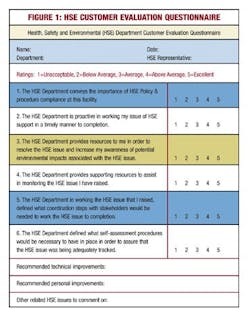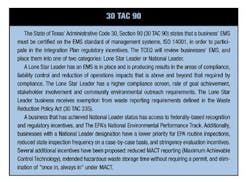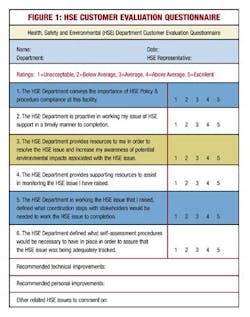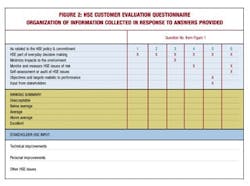A business' sustainability and, in many cases, its license to operate are defined by its Health, Safety and Environmental (HSE) commitment and policy. A company's response to HSE issues affects employees, contractors, stakeholders and the surrounding community.
Management is seeking reliable means to ensure that HSE issues are addressed. By having an MS in place, these HSE issues are evaluated and revised on a more consistent basis.
The MS has the potential to play a key role in evaluating workflow performance , thereby ensuring the health and safety of employees and personnel, maintaining regulatory compliance, enhancing business reputation within the community, satisfying customers and promoting profitability.
Regulatory incentives are motivating businesses to examine the benefits of implementing an EMS. The Texas Commission on Environmental Quality (TCEQ) may expand voluntary participation in the EMS Integration Plan to include an EMS requirement in a business's permitting process. The EMS Integration Plan and its regulatory incentives are defined in the State Administrative Code 30, Section 90 (30 TAC 90).
The State of Texas, in partnership with EPA, is the first state in the nation to offer an EMS regulatory incentive program. This Texas-based program has the potential to be used as a model for similar efforts in managing environmental issues in other states.
A key standard
ISO 14001, a worldwide standard issued by the International Standards Organization, defines EMS issues in business, including emergency response requirements and preparation for environmental incidents. ISO 14001 covers, among other things, implementation, monitoring, measurement, corrective action, procedures, standards and management. The value of the ISO 14001 standard is that it focuses on awareness of environmental impact of workflow, not job function, as a part of business.When deciding the extent of coverage for the MS, your company needs to answer several questions. Will management commit to and actively support having an MS in place? If so, will the MS center around an environmental standard or one that also applies to health and safety? If the decision is to have an integrated HSE MS, then any overlap between the standards must be considered during the planning stages. How will this overlap affect maintenance of the MS?
When the EMS is expanded to include health and safety, everyday business decisions will be driven by the HSE MS. Management will then have a more focused and cost-effective use of resources. Additional benefits include, but are not limited to: improved risk analysis, consistent documentation practices and minimization of environmental impact.
The EMS and HSE MS share several components that are central to a business, regardless of the type. The individual and collective business workflows are covered by these core components, which include: objective- and target-setting; risk management; policies, plans and setting of the business direction; organization and resources; standards and procedures; self-assessment or audits; implementation, monitoring and corrective action; and management review.
These components describe the collective workflows and objectives of the business, while simultaneously responding to changes in both business and regulatory climates. They provide a critical self-assessment tool to determine whether continuous HSE improvement is occurring, and a mechanism for communication to relevant business stakeholders. The components of the MS also provide value to business management in monitoring and measuring HSE performance and achieving continuous improvement.
The starting point
In setting up an effective MS that is based on workflow decisions, five components must be present in each stage of design.Define the HSE issue.
Make sure that authority and responsibility lines are clearly drawn so as not to interrupt workflow. Minimize the number of authorities required in the review process. Maintain an HSE Commitment and Policy statement. Ensure that the HSE issue being evaluated does not conflict with the basic components of the policy statement.Set objectives and targets.
Management should document and communicate the company's objectives and targets to both employees and contractors. This can be done at HSE meetings, through company newsletters or the company's Web site. HSE training should include a module explaining how the company's objectives and targets are determined, communicated, reviewed and updated by management, and how the employee/contractor has input into setting them. Management should formally document all of these things in the HSE MS manual.Document compliance requirements and performance.
Establish an assurance process for a person or team to monitor compliance requirements. The responsible individual or group should document, communicate and track compliance performance within the business. Make sure the authority of the person or team assigned this responsibility is clearly defined.Communicate and document the importance of HSE.
If employees are not aware of HSE's value to the business, issues that need to be addressed may not be noticed. Provide continuous training for the MS. Document training and competency testing on HSE components of the MS completed by all employees, including those in management.Allocate HSE resources.
Correlate all HSE data findings, both conformance and nonconformance, back to the core components of the MS. Management should commit to a regular review of the HSE data and information. This review process should be documented in the MS manual.Implementing the MS you have designed involves five stages.
Management buy-in
You must have management buy-in for an MS to succeed. Management should promote the program and help define the key components. These components include: organization and responsibilities; employee participation and ownership; self-assessment; monitoring and measurement; and management reviews.The MS manual should communicate a message of commitment. Management should designate a team that is responsible for implementation, monitoring, performance evaluation and management review of the program. The authorities and responsibilities for each member of the team should be defined.
To determine compliance, key performance statistics should be regularly monitored and measured. Incorporate these results into corrective and/or preventive action, reporting and management review.
Set annual business objectives and targets. Input for adjusting these goals should be based on an assessment of environmental impacts and HSE risk assessment; compliance with regulations; compliance with workflow standards (for example, ISO 14001); and waste reduction and energy conservation.
Identify and assess risk
You should identify environmental impacts and determine the basis of risk assessment. Define the type of environmental impact and area or media affected, such as air, noise or release to water. This will aid in identifying key contributors (departments or areas) to the overall workflow. Management should use this information when forming the implementation team. This ensures that you have an accurate representation of overall business workflow.
Communicate and document the significance of the environmental impact (low, medium or high), including health and safety impacts. Incorporate a procedure to review and update this information annually.
Identify the controls in place to limit the impact on the environment. Determine the tolerable level of HSE risk the business will assume. Define levels of risk with respect to employees and contractors, business operations and the company's reputation in the surrounding community.
Key environmental impacts include: air emissions; releases to water; waste management; land contamination; raw materials usage and natural resources; and environmental issues important to the surrounding community.
Issue a policy statement
Use information about environmental impacts to issue a policy statement (EMS or HSE MS) for the business. Articulate the policy as defined by management to comply with HSE regulations, to protect the environment and minimize environmental impacts, and to continually improve performance. Set HSE objectives and targets, as well as mechanisms for monitoring and measuring HSE issues. Solicit input from stakeholders when assessing MS performance. In preparation of the business plan, review the company's objectives, which should include the HSE Policy and Commitment statement.Communicate HSE performance to employees and stakeholders. Business management should review performance annually. For maximum effectiveness and buy-in, review HSE performance in partnership with work groups, such as unions and contractors.
Management should review compliance and make annual adjustments in response to both internal and external business operations. Internal audit results should have input into this process.
Self-assessment
Your company should assess the performance of its MS. Define and review HSE performance from previous years. The review should cover not only the performance achieved, but previous years' objectives and targets. Document the successes and failures in meeting your goals for continuous HSE performance improvement.Communicate, review and document management practices and procedures that succeeded in achieving continuous performance improvement. Evaluate input on performance from different departments, customers and the surrounding community. Review any existing procedures for dealing with contracting and procurement to determine their efficacy in enhancing business performance.
Determine compliance by a review of the existing process. Investigate and resolve issues of noncompliance of the company's workflows. Does corrective action work in a timely manner to identify, review, resolve and follow up on the noncompliance issue? Document and communicate responsibility and accountability for workflows within the business. Establish teams to implement, maintain and improve performance of the business. Develop and maintain an MS (EMS or HSE MS) documentation manual all personnel can use as a central reference. In addition to defining the components of the MS, this manual should contain references to standards, operating procedures and work instructions.
Are corrective action results used as input to reflect and respond to changing business conditions? Is this process documented in the business MS manual? Does the business have a stand-alone document that defines the business's objectives, targets and goals? Is this document located where personnel have ready access to it?
Final implementation
Define a document control system for the business. All procedures should be available and accessible to employees. They should be regularly reviewed or revised, controlled and managed.Communicate all training requirements for specific workflows. Define the skills and proficiency that are expected of the employees performing the workflow. Establish a managed training system to track each employee's level of competence. Maintain a training schedule and document employees' training.
Measure compliance by an auditing process to assess the effectiveness of business work processes. Are objectives and targets, as well as compliance with regulatory requirements, being met by the business? Are monitoring and measuring methods effective in gathering information about performance?
Internal audits enable a business to assess whether performance objectives and targets are being met. If they have not been met, make the necessary adjustments to achieve these goals. Business management should commitment to this in its HSE Policy and Commitment statement.
Periodic review of results, audits and incident investigations will help set objectives and targets. Know when to take corrective action and follow up for continuous improvement of performance. Are there repeat findings from self-assessment that show nonconformance? An instrument calibration program should be in place. Ensure that calibration occurs on schedule and is well documented.
Common pitfalls
Companies may encounter several common pitfalls when implementing an MS.Workflow issues. These issues include lack of resources and performance issues that are neither reviewed nor funded and so cannot be addressed. The necessary changes to make implementation more effective are lacking. Senior management has not formally named an MS team with defined responsibilities and authorities for HSE issues. Management has not made a formal commitment to the MS or the implementation team.
HSE goals not met. There is a lack of HSE awareness and impacts are not being documented by personnel. There is no procedure to review and update HSE impacts with subsequent reporting to senior management. Management does not have input on change issues that affect HSE performance. This information is not being used by management to review and set business performance goals.
Risk reduction measures not met. The business's environmental or HSE risk is not being measured. The actual and potential risk level tolerable to the business has not been defined. There is no plan for mitigating either actual or potential risk.
Instrument calibration program not implemented. There is no documentation of any calibration program. Monitoring and measuring equipment are not regularly calibrated. Calibration activities that do occur are not documented. A preventive maintenance program has not been established.
Document control system not in place. Employees cannot distinguish the current documents from those that are obsolete. There is no indication of when the documents were issued or last reviewed, of who owns the document or who has the authority to approve it.
Assessing performance
To achieve continuous improvement of HSE performance, you must have a tool to determine the effectiveness of those responsible for HSE support. The HSE questionnaire can be used by the individual and/or management responsible for the specific workflow. Responses to the questions are then ranked as unacceptable, below average, average, above average and excellent. This information is then organized and related to the MS HSE Commitment and Policy Statement. The business MS acts as the glue between the workflow interfaces to ensure continuous exchange of HSE information that directly affects business profitability. If the employees are aware of HSE issues and controls in the workflow for which they are responsible, then business is better able to consistently produce products for the customer.The information gathered from this questionnaire indicates whether the business's HSE Commitment and Policy statement is part of everyday business decisions. Also, information from the questionnaire gives management an idea of the effectiveness of HSE resource allocation and provides an avenue to discuss HSE issues. All of this has input into driving HSE performance of a business.
Rebecca Pehler is a chemical engineer and chemist with more than 24 years of experience working on the Gulf Coast. For the past three years, she has helped a major oil company design and implement an HSE MS.



